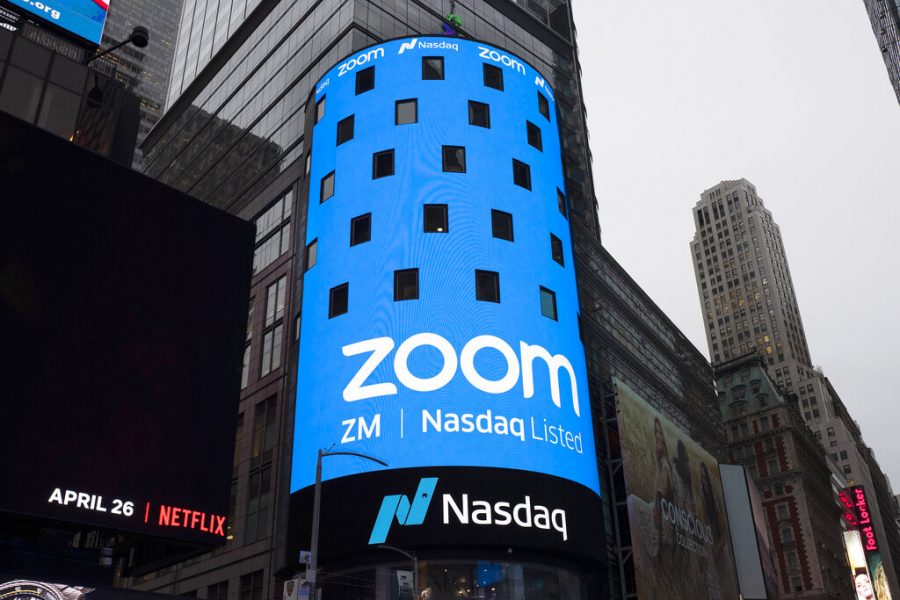The novelty, frustration, and responsibility of riding out COVID
Following COVID-19 prevention measures is frustrating, but we’re in the home stretch now—Let’s stick to it and save lives
AP
A sign for Zoom Video Communications appears on a Times Square billboard before the company’s IPO on the Nasdaq in April 2019
Over the past few weeks, I’ve grown increasingly frustrated with virtual learning. While I have excellent teachers and find my classes absorbing, school has begun to feel more and more like a grinding chore.
Each day, I attend class and do homework at the same old desk in my room. I head down to the kitchen for meals and, most days, work out on my family’s stationary bike.
My life looks like this on Monday through Friday, five days a week—After a while, it can feel a bit like Groundhog Day. I’m sure at least a few other students feel similarly.
But I’m not here to chastise the administration or to call for a full return to in-person school. In fact, I believe that we probably should not have even resumed hybrid learning.
Despite how frustrating virtual school and other strict COVID-19 prevention measures may have become, we must follow them over the coming months.
Think back to how you felt when everything first shut down because of the pandemic in March and April. Did you feel scared? Were you anxious? How did your general outlook on the world change?
If I’m going to be perfectly honest, though I was, of course, a bit scared at the beginning of the pandemic, I also found everything going on somewhat novel and exciting. Not only was history happening before my very eyes, but the pandemic also represented a much-needed break from my demands at school, my extracurriculars and my job.
Virtual learning and virtual everything else also allowed me to reconnect with myself. I explored new interests, finished books I had been meaning to read for years, and was able to consistently sleep 8-9 hours per night.
I know that I was not the only one who felt this way. While the harsh realities of the pandemic and consequent economic crisis always loomed and I recognized my privilege in not experiencing these difficulties, as a society, we also embraced the inverse freedom that it offered. Remember when everyone started making bread from scratch, or when we all became obsessed with Animal Crossing for a good month or two?
Quarantine life, when almost everyone was participating in it, could feel like a whimsical and wondrously offbeat version of conventional society.
As time went on and spring turned to summer, though, COVID-19 cases plateaued in many areas of the country, and governors lifted state lockdown measures. Slowly at first, but then snowballing as more people joined in, many Americans began returning to some semblance of normalcy.
The problem with returning to ordinary life, as many states learned over the summer, any regular gathering of people can spread the virus. Now, as autumn approaches its zenith, COVID-19 spread is at an all-time high across the country—As a whole, the U.S. reported more than 150,000 cases on Nov. 17.
Yet many people have continued to gather with others, often participating in activities they would not have dared to partake in during March and April. It exhibits what has been called “COVID fatigue,” people’s exhaustion with quarantine and social distancing practices.
As my frustration with virtual learning demonstrates, I’m certainly feeling some “COVID-19” fatigue myself.
COVID-19 lockdowns aren’t novel anymore, and people across America want to return to ordinary life. The problem is that our exhaustion with the virus doesn’t change anything about its deadly spread.
Famously, many people thought that World War I would “be over by Christmas.” Instead, the war turned into a four-year global conflict in which 20 million soldiers and civilians died.
Likewise, the COVID-19 pandemic will not go away because we wish it would not happen. It’s enormously frustrating, but it’s also something that we have to accept.
There is now a light at the end of the tunnel, though. Last week, Pfizer announced that its vaccine is more than 90% effective against the virus. Then, earlier this week, Moderna reported that its vaccine is similarly effective.
Dr. Fauci has expressed hope that this vaccine news will encourage Americans to follow best practices regarding COVID-19.
“When help is on the way… I hope we can get over the Covid fatigue,” he said in a recent interview.
Over the next six months, the estimated time it will take to distribute a vaccine, we must all echo Dr. Fauci and stick to COVID-19 prevention measures. It will not be easy, but with “help on the way” and a potentially devastating winter ahead of us, it will save lives.
And, in the end, that’s why this is so important. If someone told you that by staying home as much as possible for six months, you could directly save people’s lives, of course, you would stay home. Literally, that’s what our current situation is.
We’re in the home stretch now. Virtual learning and other COVID-19 prevention measures may be increasingly frustrating, but it’s time to kick to the finish. Stay home like people’s lives depend on it—because they do.







































